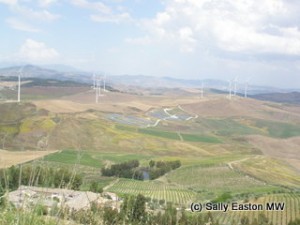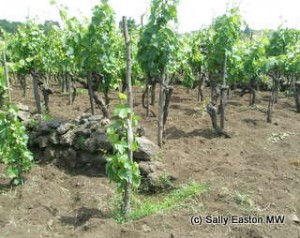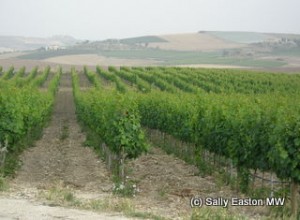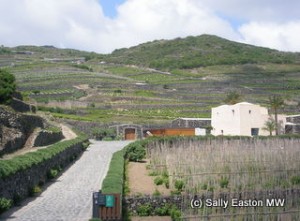Sicily – a continent on one island

Central uplands
A version of this article first appeared in Drinks Business magazine, February 2012.
A steep gradient, literally and thermally, exists from the cool, high slopes of Mount Etna in the east of Sicily to the basking west of the island, both Palermo and the island of Pantelleria, which is nearer Africa than Europe. Etna, though, is not the only place with altitude on the island. The uplands of north and central Sicily have varying degrees of height on their side. Combine this with a bevy of well-adapted local grape varieties, and Sicily has an enviable paradigm on the cool-hot spectrum.
If harvest time is any indicator of warmth, then in just 250km distance across, somewhere in Sicily harvests from the end of July in the hottest, western parts, to early November, on Etna. Even on Etna, with its crescent of vineyards stretching around the volcano, harvest at 450m is in the second half of September, while harvest at 1,000m is during the beginning of November.
Several varieties are region-specific, possibly nowhere more so than Etna, with the white carricante, plus the red nerello mascalese and nero cappuccio. Federico Curtaz of Tenuta di Fessina likens nerello mascalese and nerello cappuccio to nebbiolo, with which he still works, in Piedmont, with its high acidity, long maturation to achieve soft tannins, and late picking with not too much alcohol. And he uses 35 hectolitre and 500 litre casks to enhance the “rich, soft, sweet tannins”. Benanti’s export manager Lisa Sapienza added “nerello mascalese provides the spine and age-worthiness to cappuccio’s roundness.”

Etna's volcanic soils
Of carricante Curtaz said “it is on south facing slopes at 800 to 1,000m, and we pick late October, early November” with around 12 to 12.5% potential alcohol, and somewhere around 7g/l total acidity (expressed as tartaric). With the fresh, citrus, Chablis-like, mealy focus of his Etna Bianco, he said “it’s a wine that searches for the centre of Europe, not the south, and it could keep in bottle for around 15 years.” The variety seems best suited to the cooler, higher altitudes.
Frappato is another site-specific variety that adds fragrance, freshness and lightness of character to key island-wide variety nero d’avola in the southern part of the island, west of Ragusa, where harvest is already around the average for Sicily, meaning the latter part of August for whites, and the first part of September for reds.
Though it’s already very warm in this area, frappato is well adapted. Marco Calcaterra of Avide said “it is one of the first [grape varieties] that has body, but it is the last to reach ripeness. And on average it has 6-7 g/l of acidity, though it will lose half a gram in the winemaking”. He added “frappato is semi-aromatic. The fragrance has a good concentration of terpenic compounds” which helps to bring “elegance to the Cerasuolo di Vittoria DOCG” said Francesco Ferreri of Valle dell’Acate, in which wine it must comprise 30 to 50% of the blend.
Some 60km further west is the increasingly reputable Agrigento province, which produces good fruit from a spread of varieties, both indigenous and international. Nearer the coast, daily sea breezes are reported to reduce the temperature by around 5°C, even 20km and more inland. And further from the coast, a few hundred metres of altitude offers its own cooling effect.

Masseria del Feudo
Brother and sister team Francesco and Carolina Cucurullo at Masseria del Feudo grow nero d’avola and grillo alongside syrah and chardonnay on their 18ha vineyard. Francesco said “we’re at 500m here. It’s very hot in August, which can be a problem for merlot, but in September it’s around 25 to 28°C, and at night the temperature drops. We pick chardonnay early, with around 8.5 g/l acidity. If I waited another 7 to 10 days, the acidity would drop and I’d have at least 14% alcohol.” Grillo here has already become more elegant and florally perfumed.
Directly north of Agrigento, pretty much in the geographical centre of Sicily in the mountainous Sclafani countryside near the Madonie national park, are the likes of Tasca d’Almerita and Feudo Montoni, and only one or two others, despite both these guys making some excellent wines in these remote hills, close to no major town and a couple of hours’ Sicilian-driving from Palermo.
Fabio Sireci, the owner of Feudo Montoni, some 500 to 750m up, has a unique clone of nero d’avola, from his 85 year old, pre-phylloxera vine material. He said “Giacomo Tachis was looking for true nero d’avola. He thought mine could be one of the oldest and purest, for its age and isolation.“ Both Sireci’s nero d’avolas are fragrant, fresh and long, and his perfumed, peachy grillo comes from “clones that are not easily oxidised” and at an “altitude that gives an elegant nose, from land that is full of minerals”.
At the neighbouring Regaleali estate of Tasca d’Almerita, where vineyards have a similar altitudinal range, Guiseppe Tasca said grapes “ripen here a month later than coastal areas, [giving wines with] more freshness, wines that are longer than larger, smooth, delicate with more acidity.” Of the remote location Tasca said “there have been vineyards here since the 14th century, and there were more years ago. Now that logistics are not a problem, [grape-growing] is coming back to vineyards which are more expressive.”
Nero d’avola does not just do well here. It needs warmth to ripen properly, and has long since spread from its origin at Pachino, in the south eastern corner of the island, to account for more than 15% of the island’s vineyard area, offering different styles according to location.
Western Sicily is the hottest area, and has 70% of the vineyard area. This is where the Marsala trio of catarratto, inzolia and grillo are extensively grown. It is unsurprising the better quality grillo grape variety is migrating east from its fortified roots to find elegant expression elsewhere, as an unfortified wine style.

Donnafugata on Pantelleria
Alongside the zenith of Marsala production, arguably the most exciting wine revelling in the rich Mediterranean heat is the sweet wine of Pantelleria, which has (re-)made a name for itself through the restorative works of Donnafugata’s owner Giacomo Rallo, since a family holiday in the late 1980s took him to this small, volcanic-black, windy isle. Almost single-handedly Donnafugata have revolutionised this sweet, concentrated fresh wine, made from muscat of Alexandria, locally known as zibbibo, to a new passito glory.
The secret to passito success, said Giacomo’s daughter, José Rallo, said “was focusing on the right part of drying” under the sun, adding “we reduced the period of drying to reduce oxidation, because our focus is the fruit.”
Such wealth of well-adapted viticultural material means Sicily has all the right ingredients to exploit the island’s huge regional differences and make really exciting wines.
Sicily spreads across all five Winkler regions
| Heat Degree Days (Winkler) | MJT °C | Winkler Region | Vineyard altitude | annual rainfall (mm) | typical harvest dates | typical grape varieties planted | |
| Etna 950m asl |
1560 |
22 |
I, II |
950 m |
1190 |
3rd week Oct | nerello mascalese; nero cappuccio; carricante |
| Etna 450m asl |
2200 |
24 |
IV |
450 m |
600 |
1st week Oct | nerello mascalese; nero cappuccio; carricante |
| Contea di Sclafani |
2270 |
24 |
IV, V |
250-700 m |
670 |
2nd, 3rd week Sept | nero d’avola; inzolia; catarratto |
| Pantelleria – south |
2300 |
24.2 |
IV, V |
100-650 m |
423 |
2nd, 3rd week Sept | zibibbo |
| Agrigento |
2500 |
25.5 |
V |
200-650 m |
475 |
2nd, 3rd week Sept (for nero d’avola) | inzolia; catarratto; nero d’avola; grecanico; |
| Menfi |
2500 |
25 |
V |
100-450 m |
500 |
1st, 2nd week Sept | catarratto; inzolia; nero d’avola |
| Marsala |
2550 |
25.5 |
V |
100-350 m |
475 |
1st, 2nd week Sept | grillo; catarratto; inzolia; nero d’avola; grecanico |
| Cerasuolo di Vittoria |
2560 |
25.6 |
V |
100-500 m |
444 |
2nd, 3rd week Sept. 1st week Oct (frappato) | nero d’avola; frappato |
| Pantelleria – north |
2600 |
25.5 |
V |
100-650 m |
423 |
2nd, 3rd week Sept | zibibbo |
| Trapani |
2600 |
25.7 |
V |
100-350 m |
420 |
1st, 2nd week Sept | grillo; catarratto; inzolia; nero d’avola; |
| Pachino |
2620 |
25.7 |
V |
100-350 m |
400 |
2nd week Sept | nero d’avola; moscato bianco |
| Palermo |
2640 |
25.7 |
V |
200-650 m |
803 |
1st, 2nd week Sept | catarratto; inzolia; nero d’avola; grecanico; |
Source: Sicily regional institute for viticulture and wine
My research visit to Sicily in June 2011 was sponsored by the Sicilian Regional Institute for Viticulture and Wine.
Comments
4 Responses to “Sicily – a continent on one island”




June 9, 2012 at 2:26 pm
A continent in one little island – exactly what we thought when we were there some time ago. The other thing that is striking is that contrary to expectations (or preconceived ideas) many of the wines have a lot of freshness and elegance. Not at all heavy and overripe fruit. (Yes, there’s that there too of course.) Definitely a wine region to discover (which we will do on one of our tours this autumn). Your article inspired a short note, with a link-back, on our travel blog: http://www.bkwinetours.com/travelog/sicily-is-like-a-continent-in-one-small-island/
June 10, 2012 at 12:53 pm
Thanks for your comment Per. Couldn’t agree more. Etna, obviously, but the central highlands are also home to some lovely wines. I reckon it’s a place for more vineyards to be planted.
Hope you have a great tour in the autumn. Sally
June 14, 2012 at 10:25 am
Thanks – very interesting post, and timely as I am off to Siciy on Sunday, so will follow up! looking forward to it even more now
June 14, 2012 at 10:34 am
Hope you have a great time. It really is a wonderful place.